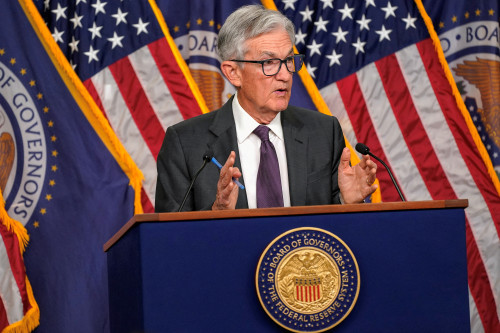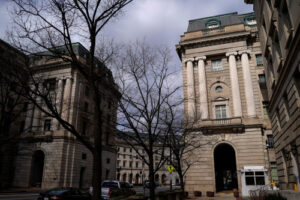By Howard Schneider and Ann Saphir
WASHINGTON (Reuters) -President Donald Trump’s pause on some of his new import taxes may have eased some of the stress building in financial markets for now, but leaves in place the same set of circumstances that had reset the U.S. economic outlook with rising recession risks and potentially rising inflation.
Major tariffs on China, Mexico and Canada remain in place, accounting for the bulk of U.S. imports, and the public, investors and the U.S. Federal Reserve now have three more months of uncertainty around where a disruptive debate will settle. In all, it sets the stage for a continued downturn in confidence that Fed officials worry is already sidelining spending and investment.
In the first remarks since Trump announced a 90-day pause on some tariffs, Fed officials made no mention of the shift, but emphasized what they had before – that the tariffs still in place had already raised the risks of simultaneously higher inflation and slowing growth.
“It appears as though we have seen a marked increase in the upside risks around inflation along with elevated downside risks to the outlook for employment and growth,” Kansas City Fed President Jeff Schmid said on Thursday. “With renewed price pressures likely, I am not willing to take any chances when it comes to maintaining the Fed’s credibility on inflation.”
Dallas Fed President Lorie Logan, in comments to a Peterson Institute for International Economics event on trade and immigration, made a similar point.
“To sustainably achieve both of our dual-mandate goals, it will be important to keep any tariff-related price increases from fostering more persistent inflation,” she said. “For now, I believe the stance of monetary policy is well positioned.”
Consumer prices fell on a month-to-month basis in March, driven lower by volatile energy prices, but analysts considered it an interlude to the tariff price shock ahead.
If the Trump climbdown on tariffs did little to shift views at the Fed, where policymakers seem ready to keep interest rates on hold until there is more clarity on the economy’s direction, neither did financial markets snap back to normal following Trump’s suspension of often steep levies on dozens of countries in an apparent nod to concerns his abrupt shift in global trade policy might spark a larger financial crisis.
Stocks surrendered much of Wednesday’s stunning jump; there was only a slight narrowing in the premium paid by less creditworthy companies to borrow and the risk premium for high-grade bonds actually increased a bit. Corporate bond issuance risks grinding to a halt, with the most creditworthy companies raising only $10 billion so far in April compared to $190 billion over a similar period in March, and only a single lower-rated issue made this month so far.
Rising costs of corporate credit and slowing corporate bond issuance can signal both a drop in coming investment spending and be a precursor of stress if weaker firms struggle to refinance or cover higher debt costs.
“I focus a lot on financial conditions, financing conditions,” St. Louis Fed President Alberto Musalem told Reuters earlier this week. “They have tightened some, tightened appreciably. If sustained that could have a headwind to growth.”
Auctions of U.S. Treasury 10-year and 30-year bonds on Wednesday and Thursday went smoothly, with yields easing on both.
Federal Reserve officials who spoke ahead of Trump’s pause said they felt markets had continued to function well throughout the turbulence that had caused global equity markets to tumble – losses partly reversed by the 90-day delay.
But there were worrying signs, including a jump in yields on U.S. Treasuries that triggered debate about whether the dollar under Trump was losing the “safe haven” status that has made the country a magnet for foreign capital, particularly in moments of crisis.
In moments of true market seizure, the Fed and other central banks can intervene with bond purchases, promises of liquidity and other backstops to keep faith that the broader financial system remains stable.
In interviews and comments this week Fed officials gave no hint they felt such conditions were developing, though they also said they were watching closely.
“As we go through this cycle of disruption we do have an obligation as a central bank to really keep our eye on liquidity,” Schmid said. “We are literally by the minute watching those markets … It looks to me like the market is adjusting pretty well for the gyrations that have been in the market the last couple of weeks. We are there if needed.”
(Reporting by Howard Schneider and Ann Saphir; Editing by Andrea Ricci)





